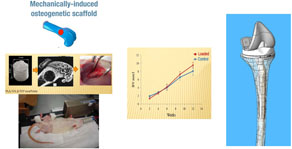The originality of our research in tissue engineering relies on two aspects. First we propose to use biomechanical stimulus to induce tissue formation in scaffold after its implantation and/or second, we use fetal cells seeded in the scaffold as a general cell source. We use this strategy specifically for bone and cartilage tissues.
Biomechanical stimulation
Based on biomechanical analysis, a composite scaffold (PLA and calcium-phosphate particles) has been developed in collaboration with the LTC (Dr. P. Bourban). This scaffold, with morphology and mechanical properties close to natural trabecular bone was implanted in rat femoral condyles. One leg of the rat was specifically loaded with a custom-made device while the other leg was kept as control. We observed a positive effect of the loading on the amount of bone formed in the loaded scaffold. The mechanical loading renders then the scaffold more osteoinductive and we propose to use this approach for specific loaded situation such as in revision of total knee arthroplasty.

Fetal cell therapy
Fetal cells obtained from specific tissues present a high potential to generate cell bank. In particular for bone and cartilage, fetal cells have been characterized and several cell banks have been obtained in collaboration with the Unit Cell Therapy at the CHUV (Prof L. Applegate). The use of these cells directly seeded in the bone scaffold greatly increase the amount of bone formed.
